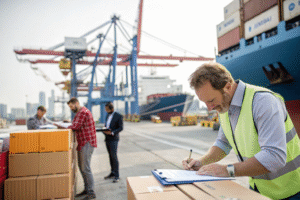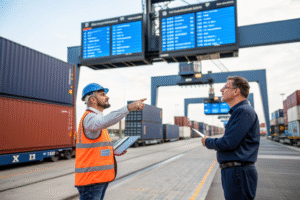New tariffs starting August 1 are targeting imports from Southeast Asia—if you're not planning ahead, you’re about to pay more.
The U.S. and EU are introducing elevated import duties on products from Southeast Asian nations such as Vietnam, Cambodia, Bangladesh, and Thailand. These include apparel, electronics, furniture, and industrial goods. To protect your costs, smart planning and the right logistics strategies are essential.
At GeeseCargo, we’re seeing a surge in client inquiries from U.S. and European buyers who rely heavily on Southeast Asia’s cost-effective manufacturing base. While these countries still offer labor and material advantages, the tariff hikes will make your imports more expensive—unless you adjust how you ship, source, and declare.
Which Countries Are Most Affected by the August Tariffs?
Vietnam, Cambodia, Bangladesh, and Thailand face the steepest import duty increases from August onward.

From August 1, 2025, tariffs on Southeast Asian imports will increase between 7% to 20% depending on product type and destination market. These moves follow the removal or reclassification of GSP (Generalized System of Preferences) benefits for many exporters in this region.
What Goods Are Being Targeted?
- Vietnam: Sportswear, electronics, leather bags
- Bangladesh: Knitwear, home textiles, footwear
- Cambodia: Garments, travel goods
- Thailand: Auto parts, electronics, plastic household goods
See the EU TARIC tool and USTR database for specifics.
Why Is This Happening Now?
Increased scrutiny on labor standards, trade balance pressures, and regional overcapacity are leading to protectionist responses from importing countries. Governments are also trying to stimulate local sourcing or nearshoring alternatives.
What Are the Best Logistics Strategies to Offset Tariff Increases?
To beat tariffs, smart logistics tactics like DDP shipping, split sourcing, and bonded warehousing are essential.

Clients using our DDP (Delivered Duty Paid) and bonded warehouse consolidation services are saving up to 18% on total landed cost despite rising tariffs.
Should You Switch to DDP Shipping?
Yes. DDP allows you to pre-negotiate customs duty, clearance fees, and final delivery as a bundled rate. This reduces the financial shock of tariff hikes. Learn how DDP shipping works.
Can You Store Goods in Bonded Warehouses?
Definitely. By shipping to a bonded warehouse, you delay duty payment until the product is sold or moved. It’s ideal if you sell across multiple regions. Learn more from bonded warehouse resources.
How Can You Reassess Your Supplier Network for Tariff Resilience?
Reevaluating your supply base lets you balance pricing and tariff exposure across multiple regions.

Some Southeast Asian suppliers may remain competitive, while others will require renegotiation. Adding secondary suppliers in low-tariff zones can provide cost flexibility.
Should You Add a Low-Tariff Country to Your Supply Chain?
Yes. Countries like Indonesia, Mexico, and India offer strategic relief. Here’s a comparison:
| Country | Avg. Tariff Exposure | Common Products |
|---|---|---|
| Indonesia | Low | Textiles, bags, furniture |
| Mexico | Very Low (USMCA) | Electronics, appliances |
| India | Moderate | Apparel, home goods |
Check rules of origin carefully to maintain tariff benefits.
What If You Must Stay with Existing Suppliers?
Then it's time to renegotiate terms—request FOB adjustments or negotiate cost-sharing on duties. You can also review classification codes through CBP Binding Rulings to seek lower-duty categories.
Can Reclassification and Accurate Tariff Codes Reduce Duty?
Yes—correcting outdated or vague HTS codes can reduce or avoid duty hikes.

Many importers unknowingly use codes that trigger higher duties. We help clients reclassify goods into more appropriate and legal tariff categories—cutting costs by up to 30%.
What Tools Can You Use?
- Tariff Lookup Portals: HTS.USITC.gov
- CBP Advance Rulings: Submit your products for pre-approved classification
- Software Integrations: Use AI-powered classification platforms like WiseTech Global
Should You Request a Binding Ruling?
If you import large volumes of a single SKU, yes. This locks in your HTS code and protects you from retroactive audits or misclassification fees. You can apply via CBP’s online portal.
How Quickly Must You Act Before August 1?
Now. Delays beyond July 25 may push you into the new duty cycle and spike your costs immediately.

Most customs systems apply the tariff based on arrival date, not shipment date. That means if your cargo hits U.S. or EU shores after August 1, the new duty applies—regardless of when it left Southeast Asia.
What Cutoff Dates Should You Watch?
| Region | Last Safe Ship Date (Ocean) | Air Freight Deadline |
|---|---|---|
| U.S. West | July 20, 2025 | July 28, 2025 |
| Europe | July 15, 2025 | July 25, 2025 |
Confirm transit schedules now with your forwarder or request a priority DDP quote.
Can We Help You Recalculate Landed Cost?
Yes. Our team uses live tariff data and shipping simulation tools to give you real landed cost projections, not just estimates. We also offer multi-origin sourcing simulation so you can visualize risk before ordering.
Conclusion
The August 1 tariff changes will reshape shipping from Southeast Asia. Whether you're importing apparel from Vietnam or electronics from Thailand, failure to adapt will mean higher costs, delayed deliveries, and compliance headaches.
GeeseCargo is here to help you stay ahead. From tariff-classification audits to bonded storage, DDP logistics, and freight rerouting—we’ve helped brands stay profitable in the face of policy shifts.
Contact Ben Zhu at benzhu@geesecargo.com to secure a customized plan before it’s too late.









